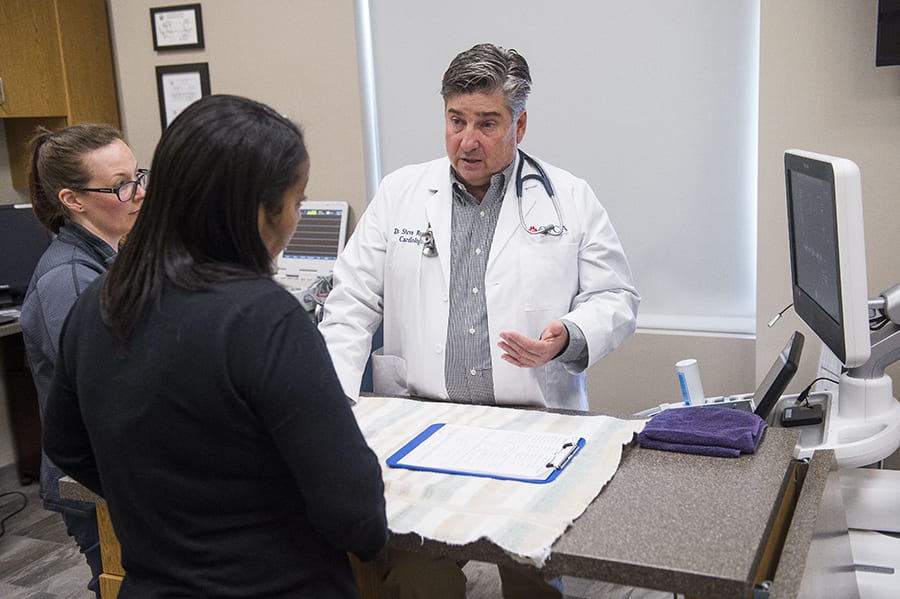What You Required to Learn About Veterinary Solutions: An Overview of Diagnostic Equipments and Procedures
Veterinary solutions play a crucial function in keeping the wellness of pets. Normal examinations can expose surprise wellness concerns early on. Numerous analysis tools and procedures, such as blood examinations and imaging methods, give vital understandings into a pet's well-being. Recognizing these approaches is vital for pet dog proprietors. What specific analysis treatments are most typically used, and exactly how can they impact a pet dog's treatment strategy?
Importance of Routine Vet Exams
While many pet dog owners may undervalue the relevance of routine vet exams, these appointments are important for keeping an animal's general health. Routine brows through to the veterinarian permit for very early discovery of possible wellness issues before they intensify right into significant problems. Normal examinations often include vaccinations, which are very important for preventing contagious conditions that can seriously influence a family pet's health. Additionally, these visits offer a chance for vets to examine the animal's weight, oral health and wellness, and total condition, guaranteeing that the pet dog is growing. Throughout these gos to, family pet proprietors can also receive useful guidance on diet regimen, exercise, and precautionary care customized to their specific pet's requirements.
Usual Diagnostic Treatments in Veterinary Medicine
In vet medication, accurate diagnosis is necessary for reliable therapy. Usual diagnostic procedures consist of blood testing strategies, progressed imaging technologies, and urinalysis, each playing a considerable function in identifying health and wellness problems. Recognizing these approaches enhances the capacity to provide appropriate treatment for animal patients.
Blood Checking Strategies
Blood screening methods act as essential diagnostic tools in veterinary medicine, making it possible for veterinarians to assess the health and wellness of pets properly. These methods include collecting blood samples to analyze numerous parts, such as white and red blood cells, platelets, and biochemical pens. Usual examinations include total blood counts (CBC), which review general health and detect infections, and biochemical panels, which analyze organ feature and metabolic condition. In addition, serological tests can identify certain diseases with antibody detection. Blood screening is minimally intrusive and offers essential details that aids in detecting conditions, checking health and wellness standing, and assessing feedbacks to treatments. On the whole, these techniques play a crucial role in making sure perfect treatment for pets and livestock alike.
Imaging Technologies Utilized
Analysis imaging technologies are necessary devices in veterinary medicine, matching blood screening strategies by providing visual insights into a pet's inner frameworks. Usual imaging techniques consist of X-rays, which work for assessing bone fractures and finding foreign objects, and ultrasound, which permits real-time visualization of soft tissues and organs. Magnetic resonance imaging (MRI) supplies in-depth photos of complex physiological locations, specifically in neurological assessments. Computed tomography (CT) provides cross-sectional images, enhancing diagnostic accuracy for various problems. Each of these modern technologies help vets in detecting ailments, intending therapies, and checking recuperation. By integrating imaging innovations, veterinary professionals can better examine a pet's health and wellness and make notified decisions concerning their treatment.
Urinalysis and Diagnostics
Urinalysis works as a vital diagnostic tool in vet medication, offering valuable understandings right into an animal's total wellness and helping in the detection of numerous problems. This non-invasive procedure assesses pee examples to evaluate kidney feature, hydration condition, and metabolic conditions. Common parts analyzed consist of certain gravity, pH levels, sugar, proteins, and the visibility of blood or microorganisms. Unusual findings can indicate problems such as urinary system tract infections, diabetic issues mellitus, or kidney disease. To boost diagnostic precision, urinalysis is commonly carried out combined with other examinations, such as blood work and imaging research studies. Early detection with urinalysis can lead to timely treatments, enhancing the diagnosis for many vet people. As a result, it is an important facet of comprehensive vet treatment.
Recognizing Blood Examinations and Research Laboratory Analysis
Comprehending blood examinations and lab evaluation is essential in vet medicine as it assists in identifying various health and wellness conditions in animals. Different kinds of blood tests provide essential details concerning a pet's inner state, while translating laboratory results requires careful consideration of various factors. This section will explore the kinds of blood examinations readily available and the significance of their results.
Kinds Of Blood Examinations
Blood tests play an important duty in vet medicine, providing essential understandings into an animal's health and wellness condition. Various kinds of blood examinations are made use of, each serving various purposes. Full blood counts (CBC) assess general health and discover conditions such as anemia or infection. Biochemical accounts examine body organ function by measuring enzymes and electrolytes, offering insights into metabolic health. Serological examinations identify certain antibodies or virus, helping in the diagnosis of infections or autoimmune conditions. Blood typing guarantees risk-free transfusions, while coagulation examinations evaluate the blood's ability to clot, important for procedures. These examinations jointly enhance medical diagnosis, treatment preparation, and monitoring of a pet's health, illustrating the value of thorough lab evaluation in veterinary care.

Translating Lab Outcomes
A detailed analysis of lab results is important for accurate medical diagnosis and treatment in vet medication. Translating lab results calls for an understanding of regular recommendation ranges and the significance of deviations. Blood tests can reveal numerous wellness signs, such as body organ feature, electrolyte balance, and the visibility of infections. Veterinarians must take into consideration the entire clinical image, including the pet's history, checkup searchings for, and any signs and symptoms provided. Variants in results might occur from variables such as age, breed, and underlying health problems. Consequently, laboratory results must not be seen in seclusion but instead as component of an all-inclusive analysis method. Precise analysis permits customized therapy plans and much better end results for veterinary individuals.
Imaging Techniques: X-rays, Ultrasounds, and Beyond
Imaging strategies are vital tools in vet medication, providing important understandings into the health and wellness of pets. Amongst one of the most typically utilized approaches are Ultrasounds and x-rays. X-rays are important for picturing bone frameworks, aiding vets identify fractures, tumors, or foreign items. This technique is non-invasive and fast, making it excellent for urgent situations.Ultrasounds, on the other hand, utilize acoustic waves to create pictures of soft tissues and organs. This technique is particularly helpful for analyzing the heart, abdomen, and reproductive body organs, enabling veterinarians to examine problems like fluid accumulation or organ abnormalities.Beyond X-rays and ultrasounds, advanced imaging techniques such as computed tomography (CT) and magnetic resonance imaging (MRI) are increasingly made use of in vet technique. These approaches use thorough cross-sectional pictures, enhancing the precision of medical diagnoses and therapy plans. Cancer Veterinary Near Me. Overall, imaging strategies play a crucial duty in making sure efficient veterinary treatment
The Function of Biopsies in Diagnosing Pet Wellness Issues
Accuracy in diagnosing wellness concerns in family pets typically hinges on making use of biopsies, which give conclusive information concerning tissue abnormalities. A biopsy includes the removal of a tiny sample of cells for evaluation under a microscopic lense, enabling veterinarians to determine various problems, consisting of infections, growths, and inflammatory diseases. This analysis device is necessary for comparing benign and malignant growths, assisting therapy choices, and assessing the seriousness of a condition.Biopsies can be done making use of different strategies, such as needle goal, incisional biopsies, or excisional biopsies, relying on the location and sort of cells entailed. The choice of technique might affect healing time and the quantity of cells accumulated. Ultimately, the info amassed from a biopsy can lead to targeted therapies, enhancing end results for animals dealing with significant health challenges. Veterinarians stress the relevance of this procedure in achieving precise diagnoses and efficient therapy strategies.
Advanced Diagnostic Devices: Endoscopy and CT Checks

Advanced diagnostic tools, such as endoscopy and CT scans, play an important role in modern vet medication, using non-invasive techniques to imagine interior structures and detect numerous problems in animals. Endoscopy involves making site use of a flexible tube equipped with an electronic camera, enabling veterinarians to check out the stomach tract and breathing system straight. This technique can disclose irregularities such as tumors, foreign bodies, or swelling, allowing targeted therapy plans.CT scans, on the various other hand, utilize innovative imaging innovation to create in-depth cross-sectional pictures of the body (CT Scans For Animals). This technique is specifically beneficial for evaluating complicated structures like the brain, back, and joints. By supplying high-resolution photos, CT scans aid veterinarians in recognizing problems that might not appear via traditional radiography. With each other, these innovative tools improve analysis accuracy, enhance therapy outcomes, and inevitably contribute to much better overall animal wellness management

Interpreting Examination Results: What Pet Dog Owners Must Know
Understanding examination results can be a tough task for pet dog owners, specifically after advanced treatments like endoscopy and CT scans have been executed. Interpreting these outcomes requires a grasp of clinical terminology and a clear understanding of what the searchings for indicate regarding the pet dog's health and wellness. Vets typically give explanations, yet the complexity of the results can still bring about confusion.Pet owners must proactively engage in discussions with their vets, asking inquiries to clarify any type of unpredictabilities. It is important to recognize normal versus irregular results and the effects for the pet's treatment plan. In addition, identifying that some results may need additional screening or tracking can aid proprietors remain informed about their animal's health and wellness trip. Inevitably, a joint approach between pet owners and veterinary professionals fosters better health and wellness results and improves the general care experience for animals.
Often Asked Concerns
Exactly how Do I Select the Right Veterinary Center for My Animal?
Selecting the best veterinary center includes investigating regional options, assessing qualifications, visiting facilities, and assessing team communications (CT Scans For Dogs). Focusing on suggestions from trusted sources can aid ensure the very best care and setting for Our site a family pet's health and wellness needs
What Should I Do if My Pet Dog Declines to visit the Veterinarian?
When a pet dog declines to go to the veterinarian, it's recommended to remain calm, usage treats or toys to lure them, and think about scheduling a home browse through if anxiousness persists. Perseverance and positive support are key.
Exist Telehealth Options for Veterinary Providers?
Telehealth alternatives for vet services are increasingly available, allowing pet dog proprietors to consult with veterinarians from another location. These solutions allow discussions concerning wellness worries, guidance on minor disorders, and follow-ups without needing to visit a facility.
Exactly how Typically Should My Animal Have Oral Examinations?
The frequency of oral examinations for pets commonly depends upon their age and breed. Usually, veterinarians advise annual oral examinations, although some pets might need more frequent visits to maintain ideal dental health.

What Are the Expenses Connected With Veterinary Diagnostics?
The prices related to veterinary diagnostics can vary extensively, commonly varying from fundamental examinations like blood work to advanced imaging strategies. Variables affecting expenses consist of site here the center's area, tools utilized, and specific examinations required for each and every family pet. Veterinary solutions play a crucial role in keeping the health and wellness of pets. While several family pet owners might ignore the significance of routine veterinary examinations, these consultations are necessary for maintaining a pet's overall wellness. Additionally, these consultations provide a possibility for veterinarians to examine the pet's weight, dental wellness, and overall problem, ensuring that the animal is growing. Precision in detecting health problems in pet dogs frequently pivots on the usage of biopsies, which provide definitive information regarding cells abnormalities. Furthermore, identifying that some results may need more screening or monitoring can assist owners remain educated about their animal's health and wellness trip.